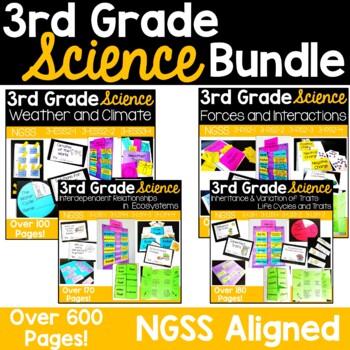3rd Grade Science Bundle NGSS
- Zip
What educators are saying
Products in this Bundle (4)
Description
Are you struggling to find engaging science materials for your third grade NGSS lessons? These science units include so many activities and resources that you can use! There are mini books, vocabulary, posters, hands-on activities, passages, and so much more!
This is a bundle of my four 3rd Grade NGSS units. Here's a breakdown of the topics taught in each unit.
- Weather Tables and Graphs
- Reducing Weather Hazards
- Climates of the World
*Climates covered in this unit are:
Desert, Mediterranean, Temperate, Polar, Mountain, Tropical
- Balanced & Unbalanced Forces
- Patterns in Motion
- Electric & Magnetic Interactions
- Magnetic Solutions to Problems
Interdependent Relationships in Ecosystems
- Animals in Groups
- Fossils
- Adaptations and Survival
- Environmental Changes
Inheritance and Variations of Traits: Life Cycles and Traits
- Plant and Animal Life Cycles
- Inherited Traits
- Environmental Influences on Traits
- Advantages for Survival
Included are mini books, hands on science activities, non-fiction passages, practice pages, interactive notebook pages, and much more! Download the HUGE preview to see what's included in this 600+ page bundle!
️❤️ Why Teachers Love This 3rd Grade Science Bundle️❤️
- Engaging activities that students ENJOY
- Easy to integrate with other science curricula
- Many options to choose from to help you hit the standards
- Teaches the standards in a kid-friendly and age-appropriate way
- Encourages critical thinking and problem solving
TEACHERS LIKE YOU SAID...
⭐⭐⭐⭐⭐ I love these units. They are so fun and engaging and everything I need to teach science. I like how it includes interactive notebook pieces, vocab and experiments.
⭐⭐⭐⭐⭐I love how well the vocabulary and activities matches with each NGSS standard. Our textbooks left us in a lurch because they talk about pieces of the standards but don't hit the nail on the head like you do. Thank you!
*NGSS and Next Generation Science Standards are a registered trademark of Achieve. Neither Achieve nor the lead states and partners that developed the Next Generation Science Standards was involved in the production of, and does not endorse, this product.
©Thrifty in Third Grade
ALL RIGHTS RESERVED





